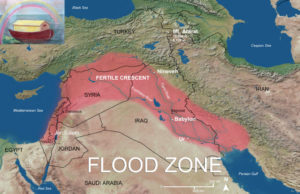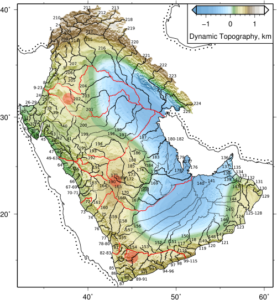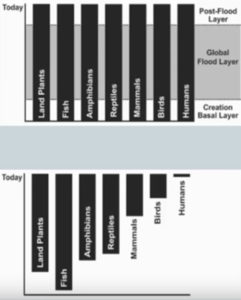 There is a concept in biblical exegesis known as the historical-grammatical method. This method suggests that in order to come to a complete understanding of the biblical text, you need to understand the literary context (the actual pages of Scripture) and the cultural context (what the author was talking about with reference to the culture). In that sense, as our knowledge of ancient cultures expands, we can expect our interpretation of the Bible to change. This could mean that church history could get it wrong because it would not know everything we do about the culture. In addition to knowledge of the culture, scientific knowledge could make some contributions. I am not sure why we should exclude scientific knowledge, as if it were second-tier information. Facts are facts. In this excellent video, the Australian YouTuber Robert Rowe examines some of the scientific and cultural data that explains how the Ancient Near East deluges us with evidence for a local flood.
There is a concept in biblical exegesis known as the historical-grammatical method. This method suggests that in order to come to a complete understanding of the biblical text, you need to understand the literary context (the actual pages of Scripture) and the cultural context (what the author was talking about with reference to the culture). In that sense, as our knowledge of ancient cultures expands, we can expect our interpretation of the Bible to change. This could mean that church history could get it wrong because it would not know everything we do about the culture. In addition to knowledge of the culture, scientific knowledge could make some contributions. I am not sure why we should exclude scientific knowledge, as if it were second-tier information. Facts are facts. In this excellent video, the Australian YouTuber Robert Rowe examines some of the scientific and cultural data that explains how the Ancient Near East deluges us with evidence for a local flood.
This would be a reference to the flood narrative of the book of Genesis. Robert compiled scientific research about the migration of human beings and the regional floods that would have occurred 8500-13000 years ago. This is coupled with commentary on the Ancient Near East and biblical exegesis from theologians. He also explains how the Neo-Ussherian model of the flood might be a little too simplistic. This could apply to the global flood or the behemoth ark size represented by Ken Ham’s replica. If you watch Robert’s lecture, he will take you through the language of the Bible, the science and the culture, totally submerging you in evidence for a local flood.
Creation Accounts That Make A Global Flood Theologically Untenable
It might surprise you to learn that Genesis 1 is not the only creation account in the Bible. Robert pointed to at least three other relevant accounts, including Psalm 104:6-9, Job 38:8-11 and Proverbs 8:27-29. The basic idea is that in the initial creation event, the earth was covered in water. We see the Holy Spirit hovering over the deep in Genesis 1:2. Robert sees a concord between this theme and modern science. The 2009 paper, The Earth Moon System During The Heavy Bombardment Period shows that in the original creation, the earth had very little landmass, and the ocean’s depth was ~1km. Of this time period, the three cited biblical passages say “You covered it with the deep as with a garment… you set a boundary that they may not pass over” (Psalm 104:6,9). Therefore, Noah’s flood could not have been global. The earth was originally almost entirely covered in water, and God said he would never let the waves pass that boundary.
Neo-Ussherians have a bit of a different interpretation. They will typically suggest that Psalm 104:6-9 is a reference to the global flood, not the creation event. But I am not inclined to think that. Verse 5 reads, “He establishes the earth on its foundations” which is a clear reference to creation. Verse 10 (coming directly after the passage I just quoted) reads, “He sends forth springs in the valleys; They flow between the mountains.” He goes on to talk about how this fresh water feeds the animals. David also writes about vegetation and other aspects of the creation event. For us to think that David departed from the creation event in the middle of a creation psalm, surrounded by texts that reiterate the events of Genesis 1 would seem like eisegesis. So, Psalm 104:6-9 really does restrict against a global flood. Second, some Neo-Ussherians suggest that if that interpretation is correct, it would also restrict against local floods. That is a sort of reductio ad absurdum. The problem is that the boundary is this larger landmass. David is looking at the original creation and telling his audience that this will never again be the state of the earth; God has set a boundary.
The same point can be made of Job 38:8-11. It is clearly references the creation narrative. In Genesis 1, the author talks about darkness. She writes, “Darkness was upon the face of the deep.” Job said of the creation of the sea, “When I made a cloud its garment. And thick darkness its swaddling band.” That looks like a parallel. Beyond that, Job also talks about the sea “coming out of the womb,” which is obviously the creation of the sea (a detail not mentioned in Genesis 1). Interestingly, God went on to say of the creation event, “Thus far you shall come, but no farther; And here shall your proud waves stop?” Proberbs 8:27-29 makes the same point. Robert’s point is that all of this establishes a tectonic profile before the flood. A global flood is both biblically and scientifically implausible.
The Regional Flood In Earth’s History
 Neo-Ussherians typically regard Noah’s flood as a powerful mechanism to explain relevant scientific data. If you think about it, it is a pretty powerful resource. If Neo-Ussherians did not have the global flood, I am not sure how they would account for geological discoveries. Of course, Robert did not spend much time exploring the global flood as a scientific explanation. But he did some research into peer-reviewed studies that showed that there was a great regional flood that extended almost 100 kilometers. This discourse began as he talked about the 2005 paper, New Evidence for the Expansion of Upper Pleisocene Population Out of East Africa from the Site of Station One, North Sudan. This paper cites tool technology that supports the Out of Africa theory of early human migration.
Neo-Ussherians typically regard Noah’s flood as a powerful mechanism to explain relevant scientific data. If you think about it, it is a pretty powerful resource. If Neo-Ussherians did not have the global flood, I am not sure how they would account for geological discoveries. Of course, Robert did not spend much time exploring the global flood as a scientific explanation. But he did some research into peer-reviewed studies that showed that there was a great regional flood that extended almost 100 kilometers. This discourse began as he talked about the 2005 paper, New Evidence for the Expansion of Upper Pleisocene Population Out of East Africa from the Site of Station One, North Sudan. This paper cites tool technology that supports the Out of Africa theory of early human migration.
This corresponds with the original creation of human beings in Genesis 1 and 2. Robert made the point that Genesis 1 does not refer to Adam and Eve or even an original pair. It just says that he made mankind in his image. So, Genesis 1 was prior to the great migration while Genesis 2 came after it. The 2009 paper Pleistocene Climate Change in Arabia: Developing A Framework for Hominin Dispersal over The Last 350 ka demonstrates that there were volcanic eruptions about 74000 years ago. The volcanism forced our ancestors into small population pockets within the region, which would have left them more vulnerable to natural disaster, such as a regional flood.
In fact, there is evidence for a great deluge in Arabia between 8500-13000 years ago. In the 2014 paper entitled The geomorphological and hydrogeological evidences for a Holocene deluge in Arabia, the authors explained what caused the deluge. They write, “The formation of several wadi canyons and funnel cuts along the entire Tuwaiq clearly suggests that the breaching of this conspicuous escarpment was sudden and rapid, as the northern outlet of this mega-lake was sufficient to discharge the water.” It is plausible that Noah was a descendant of those humans who were forced into a small population pocket left vulnerable to that regional flood. The image to the left shows what could be thought of as the biblical flood. The dates being 8500-13000 years before present and the affected region would both correspond with the biblical data.
Putting The Flood In Its Literary Context
If you are looking at the Bible with a Neo-Ussherian framework, the scientific and biblical evidence might uproot your entire system and make understanding the Bible a little difficult. If you start with this idea that Genesis 1 account is 144 hours long, the following chapters might not make a whole lot of sense when you put them in their literary context. Robert pointed out that this wooden, literalist way of looking at Genesis might not be the best approach. In Genesis 2:4, God’s word says “These are the generations of the heavens and the earth when they were created, in the day that the LORD God made the earth and the heavens.” In this context, the word day would not be referring to a 24 hour period. It would refer to the entire creation account. According to Robert and other day-age creationists, that would be the interpretive framework for understanding the days in Genesis 1. They are long periods of time.
As Neo-Ussherians venture further into Genesis 2-3, they may develop some more unsavory conclusions. They might think based on Genesis 2:5-6 that rain had not yet fallen. But we should not have that impression. The 2012 paper Air density 2.7 billion years ago limited to less than twice modern levels by fossil raindrop imprints clearly demonstrates that there was rain on the earth. This was prior to the events that took place in the Garden of Eden. This means that Eden was a local area and did not cover the entire surface of the earth.
The Relationship of All Biological Life
Another point that might challenge the Neo-Ussherian framework is the idea is that there does seem to be some hinting toward the relation of all biological life. The text says that God created man from the dust of the earth. But according to Robert, we should not think of that as a singular man. The word rendered Adam just means Human. The word human can be taken as a singular noun or a plural. Similarly, Genesis 1:20 seems to suggest that the waters brought forth the birds of the air. The KJV’s rendering captures this interpretation. It reads, “Let the waters bring forth abundantly the moving creature that hath life, and fowl that may fly above the earth in the open firmament of heaven.” Basil The Great saw this as well. Of this passage, he wrote, “Why does the water give birth to birds? Because there is, so to speak, a family link between the creatures that fly and those that swim.” Robert sees a deep concord between modern science (even human and animal evolution) and the biblical creation account.
Of course, with that idea, the question of man’s sinful nature will arise. If there is no original sin rooted in a historical individual person, then how can we still believe in a sinful nature? Well, the ancients certainly did believe in a sinful nature, but maybe not precisely as we do. They believed in what is known as the yetzer hara. In English, this would mean the Evil Impulse. In his study of Ephesians 2:1-10, Robert actually argued that Paul thought about sin within that framework. Interestingly, many scholars think the yetzer hara is present in Genesis 2:7 when God speaks of forming man. But there is an interesting linguistic event. The word formed, which should be spelled Yod-Tsadde-Resh actually contains two Yods. That is not a misspelling, because the Dead Sea Scrolls contain the double yod. Further, the same passage uses the same word with the correct spelling. Many scholars conjecture that the two yods represent the two impulses, namely good and evil. God created man with both.
Whole Earth Language
Probably the most compelling aspect of the Neo-Ussherian flood is the language that refers to the whole earth. The text suggests that the entire earth was covered and even the mountains were covered. But if you put that in its literary and historical context, the argument becomes less persuasive. For example, in Genesis 2:11 when referring to the Pishon River, it uses the same phrase. It is rendered “whole land of Havilah” in Genesis 2, but it is still the exact same wording. If we were to use the Neo-Ussherian standard here, we would think that Pishon was a global river.
Beyond that, there is a common literary device seen throughout Scripture known as phenomenal language. Phenomenal language occurs when a character or an author relays what she can see. Joshua could see the sun standing still, and that is what he described. In the flood narrative, Noah would have looked out on the horizon from every side and seen just water. The highest mountains in the land (earth) were covered. He would have described it by saying that the whole earth was flooded. A similar point that I brought up here is that the whole earth language could be a poetic exaggeration to express the utter calamity of what happened. It would be like when Isaiah 13:10 says of the Babylonian Captivity that the stars are falling from Heaven. It could be taken as a poetic exaggeration.
Further, Robert cited an extended footnote in Dr. Michael Heiser’s excellent book The Unseen Realm. Heiser writes, “Second, Genesis 9:19 clearly informs us that the whole earth was populated by the sons of Noah. Genesis 10 gives us a list of the nations spawned by the sons of Noah – all of which are located in the regions of the Ancient Near East, the Mediterranean, and Aegean. The biblical writers knew nothing of nations in another hemisphere. The language of Genesis 10 therefore allows Genesis 7:21 to be restricted only to the people groups listed in the Table of Nations. That interpretation is consistent with a localized flood.”
However, there are instances in the Bible that refer to the whole earth. If the author of Genesis wanted to establish that there was a global flood, she would have used the same Hebrew words. Psalm 24:1 reads, “The earth is the LORD’S, and all it contains, The world, and those who dwell in it.” When speaking of the entire inhabited world, Hebrews used the word tebel, specifically when it is used with eres.
Predictive Capabilities
 Typically a scientific model is measured by its predictive capabilities. If there was a global flood, we would have certain expectations of the fossil layers. Dinosaurs and humans would have died in the great deluge, so we would expect that their remains would be together. But that is not what we find. If you look at Robert’s two charts to the left, you will see the predictions of global catastrophism compared to what we actually find in the scientific record.
Typically a scientific model is measured by its predictive capabilities. If there was a global flood, we would have certain expectations of the fossil layers. Dinosaurs and humans would have died in the great deluge, so we would expect that their remains would be together. But that is not what we find. If you look at Robert’s two charts to the left, you will see the predictions of global catastrophism compared to what we actually find in the scientific record.
When confronted with scientific evidence such as this, Neo-Ussherians often reply by denying uniformitarianism. They suggest that the laws of nature have varied throughout the generations, and there were extremely aggressive plate tectonics. There are a few problems with this. First, if a man were on trial for murder and confronted with DNA evidence, he would not be able to suggest that the laws of nature have changed. That would be an unevidenced, ad hoc measurement to avoid the implications of the argument. Second, the Bible states that God has made a covenant with nature and for him to break that covenant would be akin to breaking his covenant with Israel (Jeremiah 33:25-26).
Finally, the scientific evidence shows very little variation within the laws of nature. The 2013 paper Search for variation of the fine-structure constant and violation of Lorentz symmetry using atomic dysprosium showed that linear variation is found to be as low as 2 parts in 10,000,000,000,000,000,000 per year. The laws of nature have not changed, and the predictive capabilities of the Neo-Ussherian flood are found to be wanting.
How The Ancient Near East Deluges Us With Evidence For A Local Flood
There was a lot of content from Robert’s lecture that I wanted to include but left out. I strongly recommend watching it. The research and peer-reviewed work that I cited here came from his video, and it is pretty compelling. The scientific evidence relating to the Ancient Near East establishes that there was a flood that could be the biblical flood, and the biblical and cultural evidence establishes that there probably was not a global flood.
How Theistic Evolution Outstrips Both Creationism And Naturalism
The Case For Animal Death Before The Fall